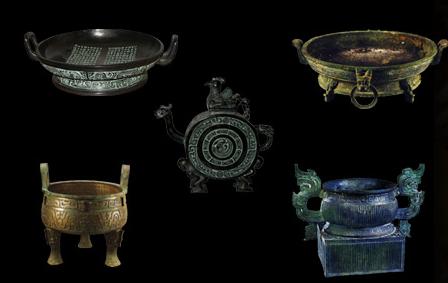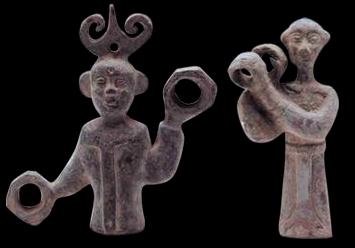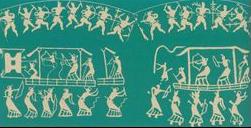
|
Cradle of Chinese civilization
|
|---|
|
By Dong Jirong ( chinadaily.com.cn )
|
|
Updated: 2011-03-04
|
|
|
|
The pottery basins with fish body designs from the Neolithic Age were unearthed in the 1950s in Banpo Village, Xi’an of Shaanxi Province. They are a testament to ancient Chinese civilization, dating back to 6000 years ago. Not only did Shaanxi see the beginning of Chinese civilization, but it was also home to the capital of 13 dynasties and cradle of Chinese ideology. It beheld the advent of the theory of Li, rites governing Chinese life for centuries. It also witnessed the ascendancy of Confucianism, an ideology that has dominated China for more than 2000 years. Ritual vessels The ritual vessels unearthed explicitly exemplify the system of Li established in the Western Zhou Dynasty (About 1100-771 BC), whose capital was Zhouyuan, today’s Fufeng and Qishan counties in Shaanxi. It’s an elaborate system preaching and institutionalizing a rigidly stratified society where each member of community had his or her own role to play.
 Left upperhand: Shi Qiang Pan Shi Qiang Pan, water vessel, middle Western Zhou Dynasty, unearthed at Zhuangbai, Fufeng, Shaanxi, dimeter 47.3m cm. On the Shi Qiang Pan was an inscription of 284 characters relating historical events that took place during the reign of the Zhou kings, which is of great importance to the study of the history of the Western Zhou. Right upperhand: Lai Pan Lai Pan, water vessel, Western Zhou Dynasty, unearthed at Yangjiacun, Baoji, Shaanxi. Middle: He He, wine vessel, late Western Zhou Dynasty, unearthed at Qijiacun, Fufeng, Shaanxi. Apart from being used in ceremonial ablutions, it also served as a container for water to dilute wine, and thus belongs to the category wine vessels. Left lowerhand: Lai Ding Lai Ding, cooking vessels, Western Zhou Dynasty, unearthed at Yangjiacun, Meixian, Shaanxi. Ding was viewed as a symbol of authority and status. The lower rank a person was, the less Dings he could use. The king could use nine Dings, the dukes seven, the high officials five, and the lower officials three or one. Right lowerhand: Hu Gui Hu Gui, food vessel, late Western Zhou Dynasty, unearthed at Qicun, Fufeng, Shaanxi, height 59 cm. Made by order of Hu, otherwise known as King Li of the Zhou Dynasty, Hu Gui was an important ritual vessel at ancestor worship. Dressing and music The use of ritual vessels is unarguably a major part of Li. However,it’s far from the whole picture. The system of Li is nearly all-inclusive in people’s life. Dressing, music, and even archery were all ritualized. The most amazing of all might be the complicated system of music for ritual occasions, which gave formal ceremonial expression to social hierarchy. There were also rigid rules concerning the size and formation of the band depending on the nature of the ritual ceremonies and the status of the host.
 Clad in robes, the two bronze figures are performers at rituals. A complicated system of dressing codes was set up in the Western Zhou. Wearing upper dress and skirts was the symbol of aristocrats, while the middle and lower class more robes. Music and dance were performed on ritual occasions.
A set of chime bells exclusively used by the Western Zhou nobles. Chime bells were the musical instruments exclusively used by the Zhou nobles. They comprised a set of bells arranged in order of size. In the early period of the Western Zhou Dynasty, a complete set included just three bells. Later on, the number increased to more than 10.
 Archery, an important skill at battlefields, was ritualized in the Western Zhou. The Zhou rules contended that the formal ceremony, with strict rules on the procedures and the use of bows and arrows, was capable of identifying talented archers. Where Confucianism came into the limelight The system of Li largely rises to a peaceful and prosperous Zhou Dynasty where people meticulously observed their social obligations. Hundreds of years later, Confucius(551-479 BC) made every effort to restore the Zhou social-political culture with his philosophy, but no states found it appealing and he failed to fulfill his political ideal in his lifetime. Xi’an, the then capital Chang’an and now capital city of Shaanxi, was the historic venue where Confucianism came into the limelight. During the reign of emperor Wudi(156-87 BC), the Han was highly prosperous and had advanced agriculture. Funerary objects found during the excavation of some Han tombs—pottery replicas of wells,kitchen ranges, storehouses, domestic animals like cattle, sheep, and pigs and iron implements like ploughs—all indicate the profound legacies the Han Dynasty left, which have affected the nation’s farming even to this day. To consolidate his rule and unify the country in terms of ideology, Emperor Wudi accepted the advice of Dong zhongshu, an ardent Confucian follower, to promote Confucianism as the dominant thought. The thought was also spread with the opening of Confucian schools nationwide. The unearthed tiles in the Han tombs still bear the inscription focusing on Confucian creeds like “Benevolence and Loyalty”. For the past 2,000 years, Confucianism has had a far-reaching influence on China and helped determine the course of the nation. |





